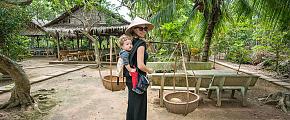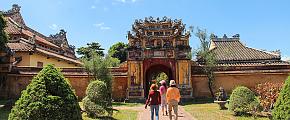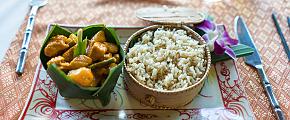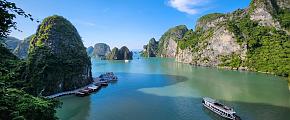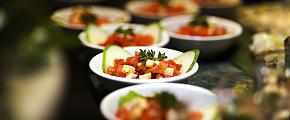10 Best Vietnam's Temples and Pagodas to Visit
In Vietnam, many local people embrace Buddhism. As Buddhism began to spread throughout Vietnam, temples sprang up one after another. Today, there are still temples of all sizes in Vietnam, which cover more than 320,000 square kilometers. People visit temples for many reasons. Some people go there and pray for good fortune, while others go to temples to appreciate the legendary scenarios and the architecture of temples. What are the main temples in Vietnam? Which temples are worth visiting? Today, we will have a visit to the top 10 Temples in Vietnam.
Tran Quoc Pagoda
Tran Quoc Pagoda is located on an island to the east of West Lake. It is the oldest temple in Hanoi. The West Lake of Tran Quoc Temple and the Bodhi tree are the temple's highlights. It is derived from the Bodhi tree that was discovered at Bodh Gaya in India 25 centuries ago.
The main attraction of Tran Quoc Temple is the pagoda garden, including many ancient pagodas built in the 18th century. The most prominent is the Pagoda in Liantai, which began construction in 1998 and was completed in 2003. The pagoda has a total of 11 stories, hexagonal shape, 15 meters high. On each floor are six Buddhas made of gemstone. At the top of the tower, there are nine layers of lotus.
With a long history of 1500 years, Tran Quoc Temple, with its historical value, unique architecture, and superior geographical location, is not only a sacred and peaceful Buddhist center that attracts many Buddhists and domestic and foreign tourists to worship the Buddha but also a scenic spot that sparks romance for the West Lake waterfront space.
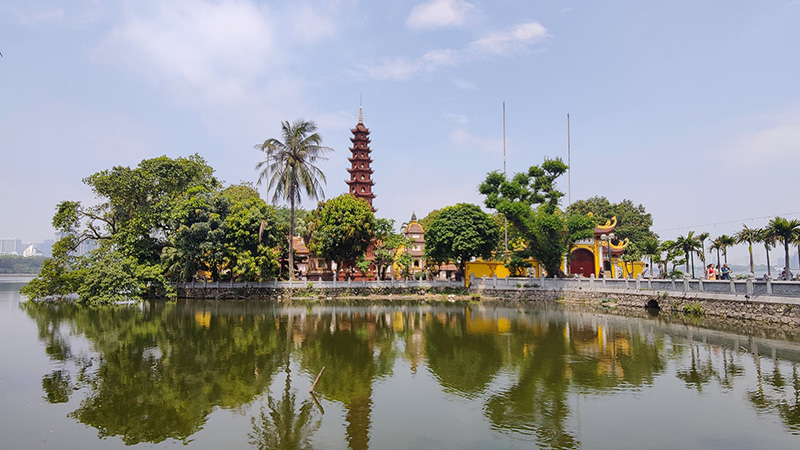 Tran Quoc Pagoda
Tran Quoc Pagoda
Temple of Literature
The Temple of Literature is located on the west side of Hoan Kiem Lake in Hanoi. It has five courtyards and takes up an area of more than 26,000 square meters.
Temple of Literature first into the courtyard by the 'Temple gate'. The second is the 'Grand Central Gate'. There are two square lotus ponds on both sides of the courtyard, and then you can see the third door: Kui Wen Pavilion.
Kui Wen Pavilion is built on four square columns, with the upper floor made of timber. The four doors on the pavilion face four directions, symbolizing the shining star of Kuiwen. It is the most famous building of the whole Temple of Literature, which was once regarded as a UNESCO symbol by the South Vietnamese government and a cultural symbol of Hanoi by the Vietnamese government.
After hundreds of years of change, the Temple of Literature has become a popular tourist attraction. During the Spring Festival, the Culture Bureau of Hanoi City will hold traditional cultural activities such as painting and painting exhibitions, chess competitions, and cockfighting in the Temple. If you are interested in it, don't hesitate to join such a big party.
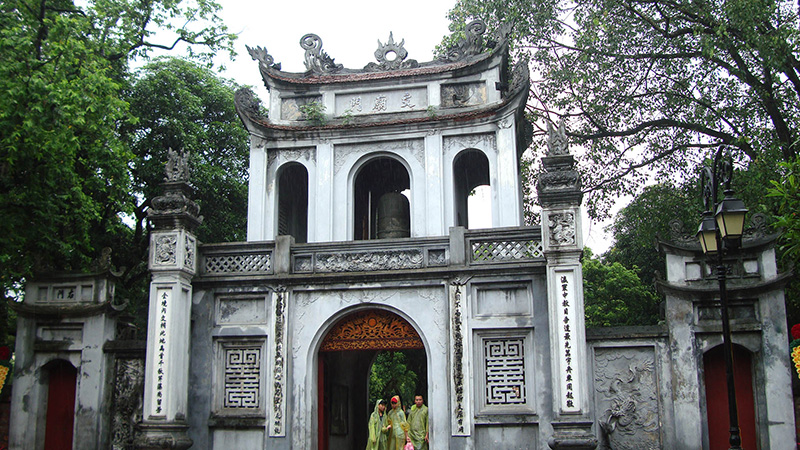 The Temple of Literature
The Temple of Literature
Cao Dai Temple
When it comes to the 'holy places' in Tay Ninh, it is important to mention the Cao Dai Temple, a unique religious architectural project in southern Vietnam. If you see from a distance, the Cao Dai Temple stands out in the green woods.
The Cao Dai temple is a masterpiece of religious architecture in Vietnam because of its exquisite architectural lines. In particular, it integrates different architectural styles in perfect harmony and embodies the cultural characteristics of many world religions such as Buddhism, Christianity, etc.
In general, the temple has the appearance of a Catholic church. On the top of the temple, there is a Lotus seated Buddha in the front, a windward table in the center, and a three-story Eight tri-gram platform behind. The main hall is a nine-fold platform, and the floor is divided into nine levels.
Cao Dai Temple has become a place for millions of worshipers from all over the world to worship and pay homage. Every year on the eighth day of the first lunar month, you can attend one of the two annual ceremonies of Cao Dai Temple, which is held from the eighth to the fifteenth day of the emperor ceremony.
Bai Dinh Pagoda
Known as the oldest temple in Vietnam, Bai Dinh Temple is the largest temple in the region. It is located in Jia Yuan County in Ninh Binh Province. At every major festival, local villagers will gather here to burn incense, worship Buddha, and offer sacrifices to show the local culture and customs.
Looking at Bai Dinh Temple from the top of the hill, you can have a panoramic view of the scenery at the foot of the mountain. The regular square building structure is laid among the grass, and the layout is orderly and well-arranged. The temple in the middle stands out, with its red walls, gray tiles, and white eaves eclipsing everything around it.
One of the attractions of the temple is the Bai Dinh Tower, the tower is about 12 stories high. Today, you can take the elevator to get to the top of the Bai Dinh Tower for the view.
As the first oldest temple in Vietnam, you can personally feel the charm of architecture.
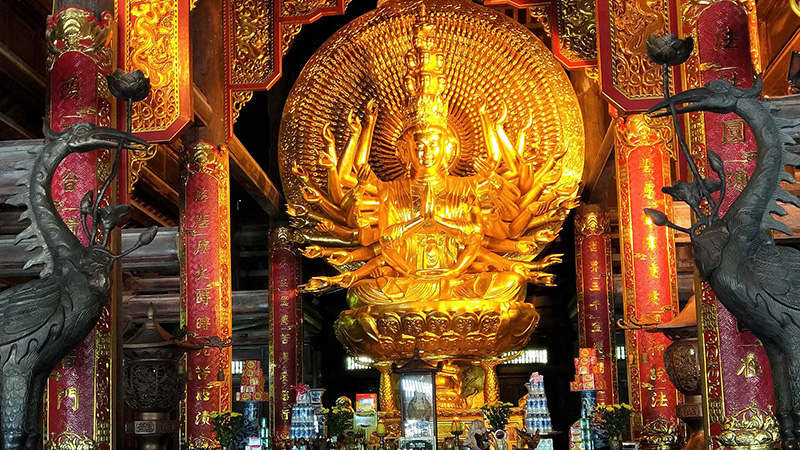 Bai Dinh Pagoda
Bai Dinh Pagoda
Giac Lam Pagoda
Giac Lam Temple is a historic Buddhist temple in Ho Chi Minh City. It was built in 1744 and is the oldest temple in Ho Chi Minh City. It keeps a large number of precious materials on religious history, culture, architectural art, and sculpture art. In 1998, it was listed as a national Historical and cultural monument of Vietnam. There are 118 Buddha statues in the temple, 113 of which are made of wood and bronze.
The wall carvings, horizontal plaques, reliefs, couplets, and other lines of Giac Lam Temple are realistic and skilled. The sculpture painting of Nine Dragon Wall with clouds and beads of water in its mouth symbolizes good weather and good weather. It infuses the atmosphere of peace and country-loving into the sacred temple.
Emperor Jade Pagoda
The Emperor Jade Temple in Ho Chi Minh City is also known as the Fu Hai Temple. Emperor Jade Temple is recognized as a national architectural and artistic monument and is the most magnificent temple. The main hall is for the Jade Emperor and the gods, and the front and upper floors are for Sakyamuni Buddha and Avalokitesvara Bodhisattva.
A temple's popularity depends on nothing more than its historical culture, its exquisite Buddha statues, and, most importantly, its efficacy. Local people say that the Jade Emperor Hall is very effective. If you go to the temple, you can pray for good fortune, passing exams, and marriage. In 2016, Barack Obama, then US President, visited Vietnam. He visited the Emperor Jade Temple, one of the most popular places for tourists.
Perfume Pagoda
If you go to the Perfume Pagoda, you will realize that the main visitors are pilgrims who come here to worship Buddha at the beginning of the year. The temple could well be a highlight of a heritage tour of the north. On Dec 25, 2017, the prime minister approved the inclusion of the Perfume Pagoda as a Historical site and place of interest in the list of national special sites.
The Perfume Pagoda comprises several temples. Most of these temples were built in the 17th century. The Pagoda can be reached by boat, and you can take the boat from Ben Duc village. When you arrive at the Pagoda, you realize that each pagoda features a different shrine, and inside the main pagoda, there are statues, stalactites, and stalagmites.
As one of the most important religious sites in Vietnam, every spring after the Vietnamese New Year, thousands of Vietnamese pilgrims come here to pray for all the happiness and prosperity. The festival starts on the 15th day of the 1st lunar month of the lunar month and leads to heavy crowds until mid-March. If you are interested in it, you can attend the festival to feel the atmosphere. The best time to visit Perfume Pagoda is from October to December. During that time, it is less crowds. You can slow your pace down, rowing on the river to enjoy the amazing scenery with beautiful water lilies blooming all over.
One Pillar Pagoda
The One Pillar Pagoda is situated southwest of Hanoi's Ba Dinh Square. It is one of Vietnam's most iconic temples, along with Perfume Temple. The Temple is named after a 1.25-meter-diameter stone pillar in the pool of Ling Zhao Pond. The temple itself is made of wood in the shape of a blooming lotus flower, a symbol of holiness in Buddhism. At the end of the First Indochina War in 1954, the temple was destroyed when the French troops withdrew. Only the stone columns remained. In 1955, the temple was rebuilt in the same style as the original temple. A stairway opens on the side, and you can enter the hall through the passageway.
The unique structure of the temple attracts many tourists and shutterbugs to record this amazing architecture. When it is sunny weather, the temple is reflected in the clear water of the pond, which makes the view very attractive.
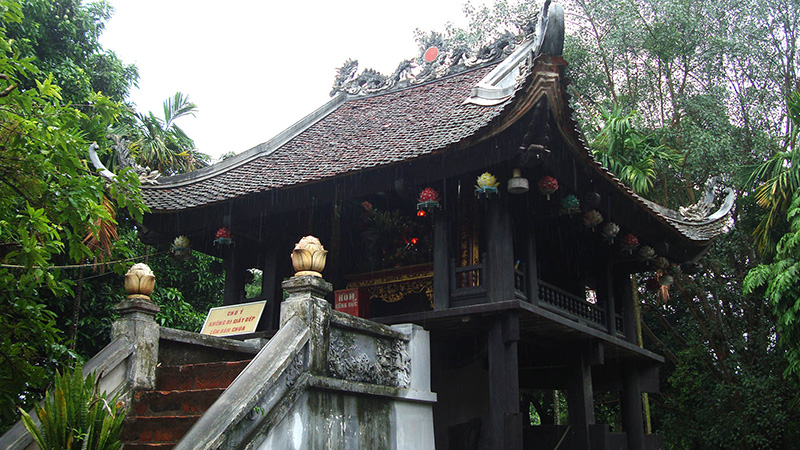 The One Pillar Pagoda
The One Pillar Pagoda
Buu Long Pagoda
The Buu Long Temple is considered one of the most beautiful temples in the world. It is set on the banks of the Dong Nai River, which forms the eastern boundary of District 9. The Buu Long temple was built in 1942 and renovated in 2007. It is 11 hectares in size, with many large and small buildings. It combines white and gold colors with carved dragons and a turquoise lake. Unlike other temples, here, only the Buddha is worshiped, which means that candles and incense are not burnt.
In the temple, the Gotama Cetiya Stupa has been viewed as the highlight spot of the temple. The stupa has five towers which come in different shapes and sizes. The main tower at the center of the stupa is the biggest and highest one. The back of the stupa is designed with symmetrical architecture in harmony with the front. The stupa is 70 m high. It is used to worship the Buddha.
Every year, the pagoda attracts thousands of locals and foreigners. When you stand at the top of the tower, you can see the entire Suburban of Saigon, Dong Nai River. It will definitely make you feel totally relaxed.
Vinh Nghiem Pagoda
Vinh Nghiem Temple is the newest and largest Buddhist temple building in Ho Chi Minh City. It has the appearance of a Japanese-style pagoda. A large Buddha statue is enshrined in the grand hall. In addition, there is a seven-story tower, and each floor enshrines a statue of Sakyamuni. On the 15th day of the first month of the year, the temple has a grand Buddhist celebration of the first month, and the scene is quite huge.
The Vinh Nghiem Temple is full of incense, and a large number of local people go to pray for good luck every Lunar New Year. The temple is exquisitely decorated and antique.
Coming to Vinh Nghiem Temple on the occasion of the Obon Festival, you can express your devotion to your parents and ancestors, as well as participate in activities such as releasing animals and praying for safety.
Today, all the temples in Vietnam are not only places of worship but also centers of spiritual and cultural activities in the community. By visiting the temple, you can not only hear historical stories about religious beliefs but also have the opportunity to experience spiritual clarity and sense the meaning of life. If you feel planning a trip is a big trouble. Don't worry. Let Odynovo help you to customize your Vietnam tour with the personal guide, so you can totally focus on your trip.

